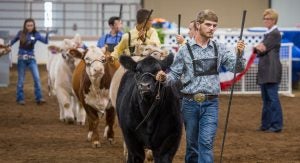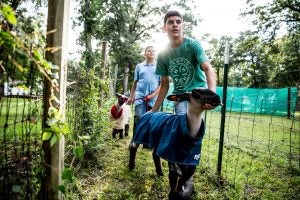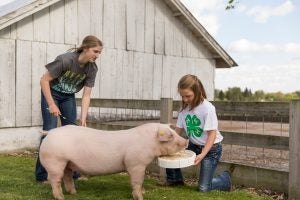The demographic of farmers and ranchers raising livestock has shrunk exponentially over the years. And, while showing livestock may not be everyone’s cup of tea, youth this summer and fall will rely on companies and individuals that purchase livestock to keep their small livestock enterprises in business.
Showing livestock isn’t always practical — but livestock exhibitors are learning skills far more profound than bucking hay or loading sacks of feed. They’re learning what it takes to lead and feed a growing population.
Local fairs culminate a year of hard work and dedication by young entrepreneurs
When businesses and individuals purchase an animal from a youth livestock auction, they’re supporting the 4-H or FFA producer and the educational programs that back and teach our youth. In most situations, the youth will also use financial support to continue participating in further educational opportunities, be that continued FFA or 4-H projects, career or technical schools, or college.
Now, it’s important to understand the junior livestock sales often bring a premium for the animals being sold. However, these young producers are operating on a tiny scale when compared to commercial producers, their costs are higher, and their livestock are cared for, trained, and monitored intensely throughout the process.

And, as many of us who’ve participated in any leadership roles in either organization can tell you, it’s not as much about buying an animal as it is buying and supporting a kid. Plus, most exhibitors and fairs are excellent at acknowledging their supporters. Many local associations are nonprofits, and livestock purchases may serve as tax write-offs.
»Related: Viewpoint: Targeting ag youth brings out the worst in animal-rights activism
So, what can one expect when they step up to support a junior livestock sale?
First off, I’d encourage anyone buying an animal to take some time during the week to go out and watch the kids prepare their animals for exhibition. Then, watch them show. The poise and leadership that so many of these youth show, even at the county and local levels, is worth taking a few hours away from a hectic work schedule to watch.
Different livestock sales will have different rules for who makes the sale. Some fairs allow each exhibitor to sell one animal; others will allow a limited number based on placement, and so on.
When it comes time for the sale, you’ll receive a catalog listing animals, their weights, and their owners. Note whether your sale is selling by the head or the pound.
As each youth enters the sale ring with their animal, an auctioneer will ask for bids. As a registered buyer, you’ll likely receive a bidding card or number; all you need to do is raise your hand when the time comes. Whether you or your company purchases that particular animal, bidding on these young livestock owners’ projects helps support the amount they’ll sell for. Everyone loves a good bidding war!

What happens after the sale?
Different types of sales occur around the country: terminal or premium (or non-terminal). Some sales will even offer the buyer the option to choose whether to sell the animal to the packer, let the exhibitor keep it, or take it home to be kept or processed later.
In the case of terminal sales, many livestock sales will offer the option to resell to a packer at (or around) market prices. As a buyer, you’ll either receive a check for the sale of that animal or pay the difference between the packer price you receive and the sale price you buy the livestock for from the youth exhibitor.
If you’d like to keep the meat, many terminal sales offer an option for buyers to send their livestock to a processing facility for personal use. For example, a whole beef weighing around 400 pounds, once processed, can feed a family for a year. After processing, a whole pig could land you over 100 pounds of retail pork cuts in the freezer.
Businesses that purchase livestock at junior livestock sales often give packaged meat to customers, employees, and friends.

If you don’t want to or can’t purchase at the sale, you can still support
While it’s exhilarating to support these young entrepreneurs by buying their animals, there are other ways to step up and support 4-H and FFA.
Many shows and sales offer an opportunity to donate to “boosters pots” that support kids who do not make a sale, or whose animals may not have done as well. Often, junior livestock shows will also let people “add on” to kids and/or their livestock projects, which means an opportunity to support or donate to an individual exhibitor without actually buying their animal.
If you’re unsure what opportunities are available locally, contact the hosting organization, FFA advisors, or 4-H leaders — they’ll be excited about anyone willing to step up and support these cornerstone programs!
»Related: 4-H teen inspires ag community after vegan backlash on social media
Heidi Crnkovic is the Associate Editor for AGDAILY. She is a New Mexico native with deep-seated roots in the Southwest and a passion for all things agriculture.



